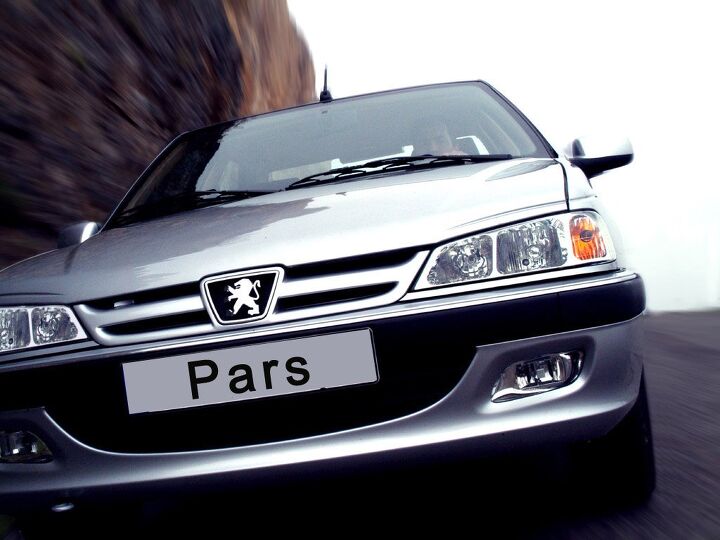Iran Is Open For Business: 1.5 Million Annual Unit Sales At Stake
Weeks prior to the historic deal reached between Iran and the “P5+1” group of nations, TTAC reported on some of the machinations going on behind the scenes regarded the United States, France and their respective auto industries ability to do business in Iran. We put forth the theory that any deal with Iran would be a boon to auto manufacturers, who would have access to a market expected to be worth 1.5 million units in a few short years, with a very young population and a standard of living that is substantially better than many highly touted emerging markets.
At the time of publication, we encountered significant dismissal, if not disagreement. But as it turned out, negotiations had been ongoing since the start of 2013, and the preliminary deal appears to make the auto industry a big winner.
Within the next 6 months, the auto industry is expected to inject as much as $500 million into Iran. The auto industry, currently worth over 1 million units annually, will be a hotly contested ground for foreign firms looking to break into the market.
Despite apparently being muscled out of Iran by their alliance with General Motors, PSA’s arrangement with GM is now as good as dead, and that means that PSA has the chance to claw their way back to the top of Iran’s market. Last year, PSA sold nearly 458,000 units in Iran (CKD kits which are being erroneously referred to as spare parts kits). Renault, which sold roughly 100,000 Logans in Iran last year, will also be able to resume business.
But American firms also appear to have designs on Iran’s auto market, with French firms becoming increasingly concerned that American companies are trying to muscle them out of Iran. Speaking to Just-Auto, an unnamed official from IKCO, PSA’s former partner in Iran, said
“This is a new day for automakers. More than [just] previous partners, we can also host more automakers which are interested to come to invest in the automotive sector of Iran.”
French officials have previously asserted that GM’s desire to have PSA end its relationship with IKCO was a way to clear out Iran’s auto market prior to the resumption of trade between the two countries. Indeed, the sanctions regime, as well as pressure from GM, caused Renault and PSA respectively, to withdraw from Iran – leaving a 585,000 unit hole in a 1.2 million unit marketplace.
Previous TTAC reports have outlined how GM officials have been clandestinely meeting with Iranian officials via intermediaries – at the time it appeared to be in violation of sanctions, but new information, asserting that high-level talks between the two countries had been going on since early 2013, have given those discussions some legitimacy.
But now, Iran is open for business not just for GM or any other American firm, but auto makers in Germany, Italy and beyond. The broader questions – whether the deal between Iran and the West is a good one, or whether it’s worth negotiating such a deal in return for the associated economic opportunities – are best left for another arena. What’s germane to our discussion is the future of Iran’s auto market and who stands to benefit.
A foothold, if not outright dominance, of a major emerging market is substantial prize for any automaker forced to compete in a mature global market with an over-saturation of brands and increasing need for volume and scale. Prior to the deal, auto makers were looking to Indonesia, South Africa and other markets that are substantially poorer, with lesser prospects for growth. The BCG report on emerging markets even shied away from speculating on Iran due to political instability. But all of a sudden, Iran is now open for business, and by the end of the decade, its auto market is expected to be 50 percent larger than Australia’s. It’s unclear which auto makers will rush in to this market. But Iran appears to be wasting no time.
More by Derek Kreindler
Latest Car Reviews
Read moreLatest Product Reviews
Read moreRecent Comments
- Ras815 Ok, you weren't kidding. That rear pillar window trick is freakin' awesome. Even in 2024.
- Probert Captions, pleeeeeeze.
- ToolGuy Companies that don't have plans in place for significant EV capacity by this timeframe (2028) are going to be left behind.
- Tassos Isn't this just a Golf Wagon with better styling and interior?I still cannot get used to the fact how worthless the $ has become compared to even 8 years ago, when I was able to buy far superior and more powerful cars than this little POS for.... 1/3rd less, both from a dealer, as good as new, and with free warranties. Oh, and they were not 15 year olds like this geezer, but 8 and 9 year olds instead.
- ToolGuy Will it work in a Tesla?


































Comments
Join the conversation
the agreement is only for six months...sounds like a big bet to go all in on the Iranian market when you may be back to square 1, or even square 1 minus 1 (military action) 6 months from now
Among other things, the agreement lets Iran purchase spare parts for their civil aircraft fleet. If you've ever been to Iran, a lot of the airliners there are 727s, older 747s, A300s, and there is even one airline (Saha Air) who until very recently was the very last airline in the entire world to fly 707s with commercial passengers on them. Toyota pulled out of Iran in 2010. I wonder if they're watching what is going on and are considering returning.